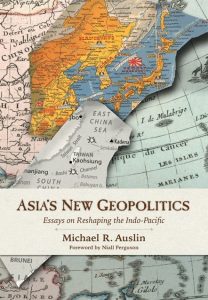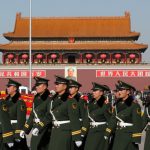
“Who controls the Rimland rules Eurasia, who rules Eurasia controls the destinies of the world.”
—-Nicholas Spykman
The author begins with referring to geopolitical thought of Nicholas J. Spykman, who, in his book, America’s Strategy in World Politics wrote “Geography is the most fundamental factor in the foreign policy of states” because it is the most permanent. Even more than the size of a state, it is location, both in the world and in a particular region is important. Coastal territories or “rimland” has the advantage because of the population, resources and access to sea. Based on this, Auslin revives the concept of an Asiatic Mediterranean which is composed of marginal seas such as the Sea of Japan, the East China Sea, and the South China Sea, Yellow Sea and its adjacent rimlands have been a major venue of great-power competition since the 1895 Sino–Japanese War and because of this geopolitical importance of inner seas or marginal seas and China’s control over these marginal seas can give it access to the Pacific Ocean and sea lanes of communication connecting the Indian and Pacific Ocean.
The “Indo-Pacific” places significant importance as a key player in the twenty-first century and as the new theater for strategic competition in world politics. In the book Asia’s New Geopolitics: Essays on Reshaping the Indo-Pacific, Michael R. Auslin presents a series of essays touching on the richness and diversity of the region as well as major security issues: With over half of the world’s population (more than three billion) living in countries around the Pacific and the India Ocean. Asia has increasingly become the centre of the world economy, accounting for nearly 40% of GDP. The rise of China and its expanding economic, political, and military engagements, from Europe and Africa to Asia and the Pacific, were shifting the strategic realities for India, Canberra, Tokyo, and Washington, DC.
The book comprises eight essays. Altogether, these essays form a comprehensive overview of the current geopolitical situation in the Indo- Pacific region.
In the book’s first section: Asia’s Mediterranean, the author correctly addresses that post cold war, the United States started believing that western capitalist model had triumphed and assumed that China would eventually follow the same development path and adopt many of the norms that the United States had established in the post–World War II era, including adherence to international law, free trade, and more open societies. Until Admiral Harry Harris statement— “the nature of the US-China relationship was shifting from cooperation toward confrontation”, successive US government for decades have been trying to ignore offensive or threatening Chinese behavior like 1989 Tiananmen Square massacre; industrial and nuclear missile technology espionage; construction of military and industrial outposts on artificial islands it has built in disputed waters. China is contesting control not only of high seas, but of the marginal seas and skies of Asia and according to Spykman’s formulation, control of the Asiatic Mediterranean means control of Asia. China today is not only threatening Japan and Southeast Asia, but its domination in the region is also severely limiting America’s global strategic freedom, and potentially threatening the nation’s well-being. The Author also suggested what is needed to be done to ensure that no aggressive power gains control over the Asiatic Mediterranean and to maintain balance of power in the region. Firstly, US Indo-Pacific command to maintain control at strategic checkpoints. Secondly, Intelligence, Surveillance and reconnaissance (ISR) activities should be strengthened.
Thirdly, deepen cooperative discussions with both allies and partners which includes joint patrols, agreement, sharing of intelligence in the region. In this section, Michael R. Auslin correctly addresses a short-sighted focus on a single sub-region at a time as a weakness of U.S. Indo-Pacfic strategy, arguing for an approach that considers the region as a whole.
The book’s second essay, “The New China Rules”, likewise addresses U.S. concerns over growing Chinese influence in the Indo-Pacific and beyond, pointing to China’s economic, military, and cultural statecraft. In this section, Auslin refers to Chinese Communist Party (CCP) which seeks to make China as a dominant global power and call it the “new China rules”. These rules include aggressive theft of intellectual property (IP) from around the world; widespread influence campaigns targeting media, politicians, think tanks, and educational institutions; espionage against international partners; Chinese military buildup and presence in strategic regions which pose the greatest strategic challenge in Asia and beyond. The author feels that the Chinese telecommunications giant’s global influence raises fears in many countries, particularly the United States, that the Chinese government could force it to spy, sabotage, or take other actions on its behalf. He writes, feeling of insecurity and frustration led China to rely on military capability to threaten the positions of countries with which it has disputes. The global influence of China, as per Auslin, displays itself mostly in cultural forms. Some of this are the establishment of Confucius Institutes to monitor overseas Chinese students not to engage in anti-Chinese activities.
One of the more interesting essays in the book, is “Can Kim Jong-Un Control His Nukes?” focuses on dangers posed by nuclear North Korea. The point of this chapter is that it’s very hard for a country like North Korea to maintain a nuclear weapons program safely. Even the countries like United States and Soviet Union have had dozens of accidents with its nuclear forces during the height of the Cold War. Operating nuclear weapon is a huge, expensive and complex responsibility and author is not sure about who in North Korea’s maintain political control over weapons and don’t know if Kim Jong-un has the capability to be a rational nuclear decision maker, and there’s no indication of availability of crisis response infrastructure; early warning system; command, control and communication intelligence to identify threats and avoid nuclear accidents so that an accident won’t trigger a nuclear exchange.
The fourth essay in the book is “India’s Missing Women”, written by the author is based on interviews of three women he met few years ago. Each of these women dealt with their challenges very differently. Essay focuses on issues of gender, caste system, widening sex imbalance (that is more males than females) continue to play a significant role in shaping economic development. Though India is steadily increasing its global role, social attitudes at home continue to change too slowly to benefit millions of educated women, who often continue to be forced into arranged marriages and give up their professional careers. Despite inequality, a selected few India woman have risen to the very top of government and the entertainment world. India needs to taps into the skills and talents of the women and should come up with a concept called as “womenomics” to increase female representation in Indian economy leading to a much larger and powerful role in the world stage.
“Japan’s Eightfold Fence”, the fifth essay perhaps the most admirably interdisciplinary essay in the book, focuses on Japan’s journey of embracing modernity through a lens of historiography, with a broad discussion of how Japanese national identity inflects contemporary Japanese internal politics. Auslin then uses this analysis of Japanese cultural history to describe the formation of the country’s strong nationalist tradition and the influence of this tradition on Japan’s foreign policy. Though marinating certain barriers against the world so as to preserve social stability and harmony, Japan continues to do extraordinarily well on international measures of health, education, crime, and the like in its own unique way.
The subsequent essay “China Versus Japan” deals with the lengthy history behind the Sino-Japanese regional rivalry and continue to projected for long-term. For Asian nations, the great historical question is not whether they will choose the outsider America over China, but rather which Asian model to follow, that of Tokyo or Beijing. A few years ago, Japan seemed dominant; now it is China. The current competition is more direct, comprises everything from visions of civil society, driving technology innovations, military capabilities, economic development models to searching for allies at rapid speed. Whether Japan remains allied to the US or not, whether China successfully build up a pan- Asian Belt and Road community or not, the Sino-Japanese relations and competition is a primary element that will continue to try to shape the Asian political, economic and security environment.
The goal for America remains the same as it has been since 1945—-namely, to maintain a balance of power in the Indo-Pacific region. In essay seven, author discusses the importance and strategy of US in the Indo-Pacific stretching back from the late eighteenth century to present day of 21st century. To ensure that the region remains open, peaceful, and not dominated by any single power, the US should be working more closely with allies and partners who share this vision.
In the most explosive concluding essay, “The Sino-American Littoral War of 2025: A Future History”, the author frames as hypothetical conflict between Beijing and Washington with a series of fictional attacks. An era of mistrust and current tensions could escalate into a full fledge war between China and the U.S.A, and accidents on the high seas and skies of Asia. All the scenarios laid out by author are fictional.
Overall, the book is well written and makes for an engaging read. It follows a linear approach from historical analysis to present day developments and author succeeds in his aim of reviving older method of geopolitical thinking. Auslin’s argument is that it is the control of the “rimlands” that will determines which of the two superpowers win the unfolding the struggle for mastery in Asia.













